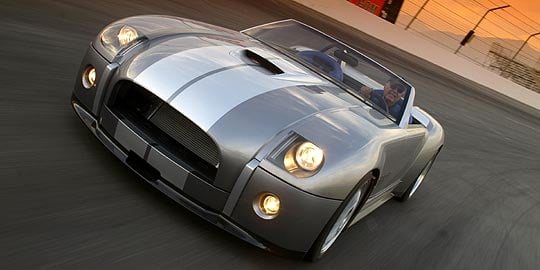
Ford Motor Company's Advanced Powertrain team had been working on an all-aluminum V-10 targeted at ultimate, naturally aspirated performance. "The Ford Shelby Cobra concept just begged for this engine," said Graham Hoare, director, Ford Research and Advanced Engineering. "Although it’s not yet ready for production, we’ve reached a credible engineering level for such a serious concept car – and it has a modern soul that matches the famous 427".
Blending the Advanced Powertrain team’s work with elements from the 4.6-liter, 4-valve V-8 used in the 2004 Mustang Mach 1, the resultant Ford Shelby Cobra concept engine has 10 cylinders and is bored and stroked for a 6.4-liter displacement, or about 390 cubic inches. It produces 605 horsepower at 6,750 rpm and 501 foot-pounds of torque at 5,500 rpm without supercharging or turbocharging.
The double-overhead-cam cylinder heads and cylinders are fed by port fuel injection and racing-derived velocity stacks that are just visible within the hood scoop. For a low hood line, the throttles are a slide-plate design and the lubrication system is the dry-sump type, which relocates oil from underneath the engine to a remote tank. The engine proudly wears brushed aluminum "Powered By Ford" valve covers.
The rear-mounted six-speed transaxle is identical to the high-performance unit in the Ford GT, with an integral limited-slip differential to drive the rear wheels. Based on the engine’s 7,500-rpm redline and the drive ratios, this Ford Shelby Cobra concept has a theoretical top speed of more than 260 mph and would break 130 mph in third gear, although it’s electronically limited to 100 mph – for now.
Front-Mounted Engine and Torque Tube
One of the challenges of fitting a 10-cylinder engine into a compact roadster is leaving room for the driver’s legs and feet. With a conventional transmission mated to the back of the engine, the tradeoff between hood length and passenger room often makes for a cramped footwell and dramatically offset pedals – a flaw of the original Cobras and many modern sports cars.
Because the Ford Shelby Cobra concept was planned from the outset to be a production-feasible "runner," not just a pretty show car, the team had to address the legroom concern. They found that mounting the transmission at the rear of the car, connected to the front-mounted engine with a torque tube, let them use a very narrow "tunnel" between the seats.
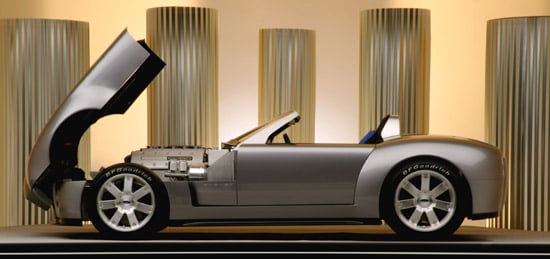
Creating a New Chassis From Existing Parts
"We knew we wanted a front-engine car that had to be ultra-compact and lightweight, yet robust enough to handle 605 horsepower," said Theodore. "There was nothing that fit the bill on first glance." But Rumpel’s team saw a creative solution.
"We were already planning to use the Ford GT suspension systems, and we asked ourselves how much more of the GT we could borrow," he said.
Quite a lot, as it turns out. Even though the GT is a mid-rear-engine car, and the proposed roadster was to have a front engine, a decision to mount the transmission at the rear made the connection. "Once we really started looking into it, we had an epiphany," Theodore said. "The project took on a new sense of purpose when we really started leveraging the Ford GT engineering."
The team worked long hours with John Coletti, head of Ford’s Special Vehicle Team, to maximize the commonality. Fresh from completing the all-new Ford GT in just 15 months, Coletti understood what it took to build fast cars faster than ever. "It was a great team effort," Coletti said. The bulk of the rear structure is made from slightly modified Ford GT components, including the massive, trellis-like cast aluminum suspension nodes, the rear rails and bumper beam, a major cross-member and the brackets used to mount the transmission.
The center portion of the space frame also has a high degree of GT commonality–major aluminum extrusions are based heavily on existing pieces. At the front of the roadster, the team incorporated the extruded main rails, steering rack cross-member, crash-management sections and the bumper beam.
Overall, the Ford Shelby Cobra concept is more than 2 feet shorter than the GT, with a wheelbase nearly 7 inches shorter. Even the track width has been reduced by more than an inch. That the concept car and the GT share any parts at all is a testimony to the flexibility of the space frame design and the creativity of the chassis team.
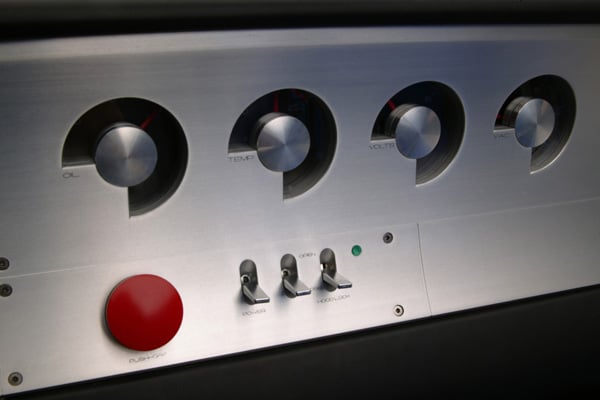
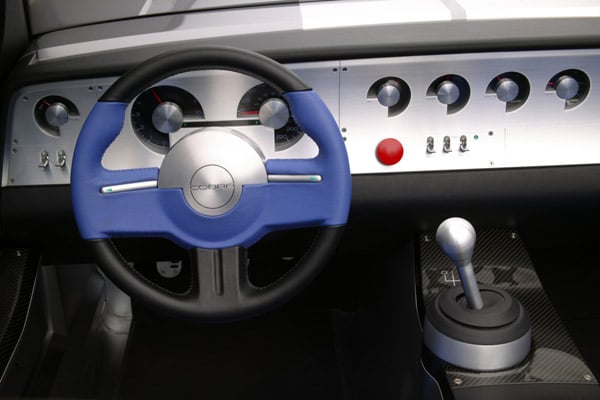
Ford GT Suspension, Steering and Brakes
To attach the massive 18- and 19-inch wheels and tires to the car, the team chose to use the Ford GT suspension system with a few modifications to accommodate the increased weight up front. Like engine technology and electronics, suspension design has come a long way in more than 40 years.
A double-wishbone suspension design with unequal-length aluminum control arms, coil-over monotube shocks and stabilizer bars is used front and rear. The upper control arms are identical at all four wheels and are made with an advanced rheo-cast process that allows the complexity of form associated with casting, yet retaining the strength of forging. The metal, heated to just below its melting point, is the consistency of butter when it is injected into a mold at high pressure. Pressure is maintained as the part cures, preventing porosity in the final product for exceptional strength.
The steering rack also is borrowed from the Ford GT, with a few modifications. The steering column, like the Ford GT’s, draws on Ford engineering best-practices like the low friction, high stiffness and light weight that have made the Ford Focus steering column among the best in the industry. Braces between the front shock towers and below the isolated engine mounts improve torsional rigidity and aid steering response.
Brembo "monoblock" one-piece aluminum brake calipers with four pistons each grab cross-drilled, vented discs at all four wheels. The discs are a massive 14 inches in front and 13.2 inches in the rear, for fade-free stopping power. But the team stopped short of fitting the car with an antilock braking system, in keeping with its racing character. Brake balance is biased slightly to the front wheels to aid stability.
The one-piece BBS wheels are wrapped by BF Goodrich Z-rated racing slicks, size 275/40R18 in front and 345/35R19 in the rear.
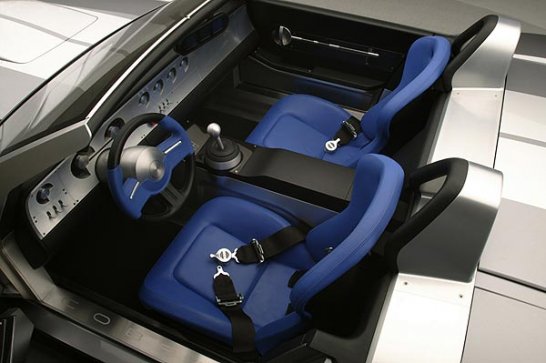
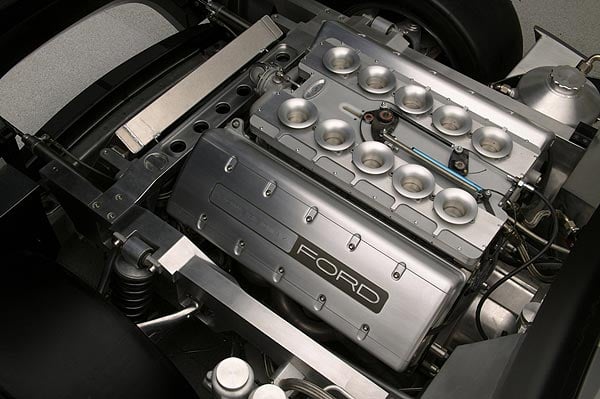
Evocative, Modern Design
Honoring the Cobra heritage is a fully modern architecture with subtle styling cues that hint at the legendary Cobras of the 1960s.
"What we’re trying to do is not just take the audience somewhere they haven’t been in a very long time, but take them somewhere they’ve never been – and there’s a lot of magic in trying to do that," Mays said.
First and foremost, the Ford Shelby Cobra concept is a performance car, and every surface and line has its roots in the car’s engineering mettle.
"The powertrain, the space frame and the suspension were all key elements in the design, although for the most part, you don’t see them," said Richard Hutting, chief designer. "These established our proportions and naturally led to a race-bred shape that evokes the original Shelby Cobra, without sharing a single dimension or proportion. Just like its underpinnings, this car is thoroughly modern in every way."
While the design is clearly 21st century, the roadster is intentionally familiar. Key details – the dominant grille opening, hood scoop, vertical bumper bars and stacked lamps front and rear – establish the historical connection to Shelby’s original creation.
"When you’re setting out to tell a story about an automobile in a fresh, contemporary way, you’re not actually looking to create beauty – you’re looking to create meaning," said Mays. "We have interpreted that raw, aggressive Cobra attitude in a very modern way."
The Ford Shelby Cobra concept completes the trilogy of Ford’s greatest performance vehicles: the GT40, Mustang and Shelby Cobra. It heralds a new era of speed from Ford, the company that best knows and most loves performance cars.
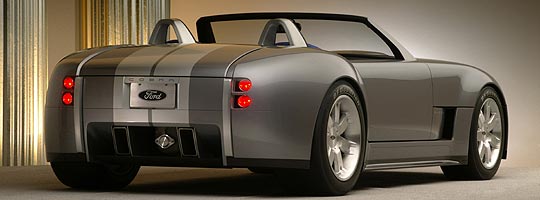
Text:Ford Media
Photos: Ford







